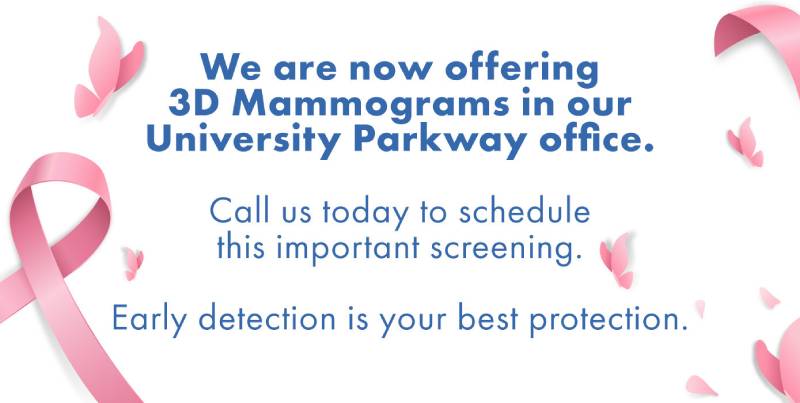Breast cancer is the second leading cause of cancer death in women, but early detection is vital to successful treatment. The most popular method for detecting this disease is mammography, and 3D mammography is the most recent development in breast imaging technology. A 3D mammogram, also known as breast tomosynthesis, is a type of breast imaging that creates a three-dimensional image of the breast tissue. In addition to improving cancer detection rates, this modern piece of technology reduces the chance of false positives and unnecessary biopsies.
This is a serious issue that affects women of all ages. Here, at University Park OBGYN, we provide cutting-edge breast cancer screening services, including 3D mammography, since we recognize the importance of early detection. Our skilled team of medical experts is committed to offering our patients the best care possible. In this blog post, we’ll go over everything you need to know about 3D mammograms, including how they can increase the likelihood of breast cancer detection.
What Is 3D Mammography?

3D mammography is a standard imaging method for the early identification of breast cancer in which X-rays are used to provide pictures of the breast tissue. A traditional form of mammogram shows two-dimensional images. Although this imaging method has been quite successful in identifying early-stage cancer, it occasionally misses tiny tumors or yields false-positive results, necessitating pointless biopsies. Tomosynthesis, another name for 3D mammography, is a sophisticated imaging technique that creates a three-dimensional picture of tissue within the breast. It is produced by combining many photographs obtained from various angles instead of only one.
The advantages of this modern technique over conventional mammography are numerous. First, especially in individuals with thick breast tissue, 3D mammography can better identify small cancers. This is due to the fact that the three-dimensional scan offers a better view of the surroundings, making it simpler to see anomalies that would be concealed in a 2D image. In addition, it increases detection rates while lowering the number of false positives, which can result in pointless biopsies.
When a mammogram detects an abnormality that later turns out to be benign, this is known as a false positive. They can put patients through additional worry and anxiety, add to medical expenses, and increase the risk of complications. Doctors may pinpoint the problem and collect a smaller tissue sample by using a 3D scan of the breast tissue more precisely, which lessens the invasiveness of the surgery. If necessary, breast tomosynthesis also enables more exact and focused biopsies.
How Is 3D Mammography Performed?
This non-invasive procedure uses a special device that takes multiple images of the breast tissue from different angles, which are then reconstructed by a computer to create a 3D image that shows up on your doctor’s screen. When you arrive at the office, you will be asked to change into a gown and take off any jewelry or clothes that might obstruct the imaging procedure. Next, the technician will place you in front of the mammography machine, which looks similar to the traditional one. During the procedure, the breast is squeezed between two plates to spread out the tissue and ensure that a precise photograph is taken. This process takes just a few seconds while they capture many photos from various angles. Although the compression could be unpleasant, it is required to guarantee a clean image. Once the procedure is over, you can go back to your regular activities right away. A radiologist will evaluate the photos and send a report to your healthcare practitioner after reviewing them.
It’s important to note that 3D breast imaging is a safe procedure, and the risks are similar to traditional mammography. While the radiation vulnerability is slightly higher with this one, the benefits of improved detection rates and fewer false positives outweigh the potential risks. At University Park OBGYN, we use the latest 3D mammography technology and take every precaution to ensure the safety and comfort of our patients.
Who Can Benefit From Breast Tomosynthesis?
While all women can benefit from breast cancer screening, it may be particularly beneficial for some of them. Due to its superior ability to detect tumors in thick breast tissue compared to standard mammography, this cutting-edge piece of technology may be especially advantageous for women with dense breast tissue. It can be challenging to spot malignant cells in them with conventional mammography since thick breast tissue and cancer both appear white on a mammogram. Multiple pictures captured from various perspectives during 3D mammography screening can aid in finding abnormal cells that could be hidden in thick tissue. A three-dimensional mammogram may also be favorable for women who have a family history of breast cancer because they are more likely to have the illness. It can find tiny breast cancers that show up during the earlier stage, which can increase the chance of successful treatment and recovery.
It’s important to remember that not all patients may be candidates for breast tomosynthesis. For those who have breast implants or certain medical issues, it may be necessary to undergo additional testing. Furthermore, even though 3D mammography is more reliable than conventional mammography at identifying breast cancer, false positive results can still happen. Your healthcare practitioner may go through your particular risk factors with you to decide whether this procedure is the best option for you.
The Importance of Regular Breast Imaging

Regular breast cancer screening is critical for early detection and successful treatment of this disease. Even though 3D mammography is a more sophisticated screening tool, it’s still crucial for women to follow their doctor’s advice and have mammograms on a regular basis. They should be aware of any changes in their breast tissue and any unexpected symptoms in addition to getting routine check-ups. Changes in the breast’s size or form, the nipple or areola, lumps or thickening of the surrounding tissue, or discharge from the nipple are all examples of this.
If your breast tissue changes in any way, or if you feel a lump somewhere on your chest or underneath your armpits, contact your healthcare practitioner as soon as possible. Additional imaging exams like MRIs or ultrasounds may also be advised as part of routine breast cancer screening, depending on personal risk factors. It’s vital to work with your doctor to choose the appropriate screening method for you based on your unique risk factors.
Conclusion
A three-dimensional mammogram is an advanced breast cancer screening method that has numerous advantages over conventional mammography. It offers a more thorough picture of breast tissue, improving the likelihood of finding abnormal changes and cells and decreasing the number of false positives, as well as the patient’s anxiety. This technique may be particularly beneficial for women with thick breast tissue. Keep in mind that routine breast imaging is crucial for the early discovery and effective management of this serious disease. In order to find the screening program that best suits your requirements and risk factors, make sure to visit your doctor.


